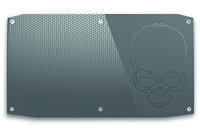Thursday, March 17th 2016

Intel Debuts the Skull Canyon Gaming NUC
Intel announced its first "gaming grade" NUC. As if the very concept of NUC wasn't disruptive to the small form-factor desktop segment enough, the company is upping the ante with one that's prepped for gaming. Codenamed NUC6i7KYK, the new Skull Canyon NUC is about double the size of the average NUC. It has sufficient muscle for sub-1080p gaming, but is also prepped for external graphics solutions, such as the Razer Core.
To begin with, the Skull Canyon is driven by a Core i7-6770HQ processor based on the "Skylake" architecture. This quad-core chip features HyperThreading, which enables 8 logical CPUs, 6 MB of L3 cache, 128 MB L4 cache, and Intel Iris Pro Graphics 580. The CPU cores run at speeds between 2.60 GHz and 3.50 GHz, while the iGPU ticks at 950 MHz. With 576 execution units, 72 TMUs, and 9 ROPs, the integrated graphics core is good enough for gaming at sub-1080p resolutions such as 720p and 900p.If you absolutely need more pixel-crunching power, then the Skull Canyon features a 40 Gb/s Thunderbolt 3 port, letting you use external graphics cards. The barebones version of the Skull Canyon will be priced at US $650, which is a bargain if you consider that the OEM channel price of the i7-6770HQ itself is $435. A fully-loaded variant with 16 GB of dual-channel DDR4-2133 memory, 256 GB SSD storage, and Windows 10 pre-installed, will be priced at US $999.
To begin with, the Skull Canyon is driven by a Core i7-6770HQ processor based on the "Skylake" architecture. This quad-core chip features HyperThreading, which enables 8 logical CPUs, 6 MB of L3 cache, 128 MB L4 cache, and Intel Iris Pro Graphics 580. The CPU cores run at speeds between 2.60 GHz and 3.50 GHz, while the iGPU ticks at 950 MHz. With 576 execution units, 72 TMUs, and 9 ROPs, the integrated graphics core is good enough for gaming at sub-1080p resolutions such as 720p and 900p.If you absolutely need more pixel-crunching power, then the Skull Canyon features a 40 Gb/s Thunderbolt 3 port, letting you use external graphics cards. The barebones version of the Skull Canyon will be priced at US $650, which is a bargain if you consider that the OEM channel price of the i7-6770HQ itself is $435. A fully-loaded variant with 16 GB of dual-channel DDR4-2133 memory, 256 GB SSD storage, and Windows 10 pre-installed, will be priced at US $999.



36 Comments on Intel Debuts the Skull Canyon Gaming NUC
IMO, the price is really coming from the Lightning connector. Because for some reason Intel thinks they can charge stupid amounts of money for anything that has one, even though almost no one uses it. If they dropped the lightning connector and dropped the price $200 this would be far more relevant, or even if they left the price the same and included a dedicated GPU like the GTX970m. But they included it, and basically said "we know the iGPU isn't strong enough, so instead of including a dedicated GPU from the start, we are going to include an expensive port so you can add an expensive external GPU configuration if you actually want to use this to play games."
They also have a 6700HQ model that has a 4K screen, 16GB of RAM, 128GB SSD, 1TB HDD, and a GTX960m and it's only $1200.
Very different use-case than this NUC though. With 960m TDP would more than double and cooling requirements would explode the form factor size. Also 15-ish inch laptop is not something one could just screw behind a monitor and be done with it.
Of course they are different use cases, but the point is considering what the laptop costs, a NUC which doesn't have a screen, keyboard, or battery should be cheaper. Yes, it is going to use more power, but not significantly. Idle should be about the same, since Optimus turns the 960m off when the extra GPU horsepower isn't needed. Load will be higher, but so will performance. I'd take the extra performance at a cost of an extra 50w under load.
For factor might be a little bigger, but also not a lot. When you strip away all that extra stuff from a laptop, you can squeeze the cooling and motherboard into a pretty small space.